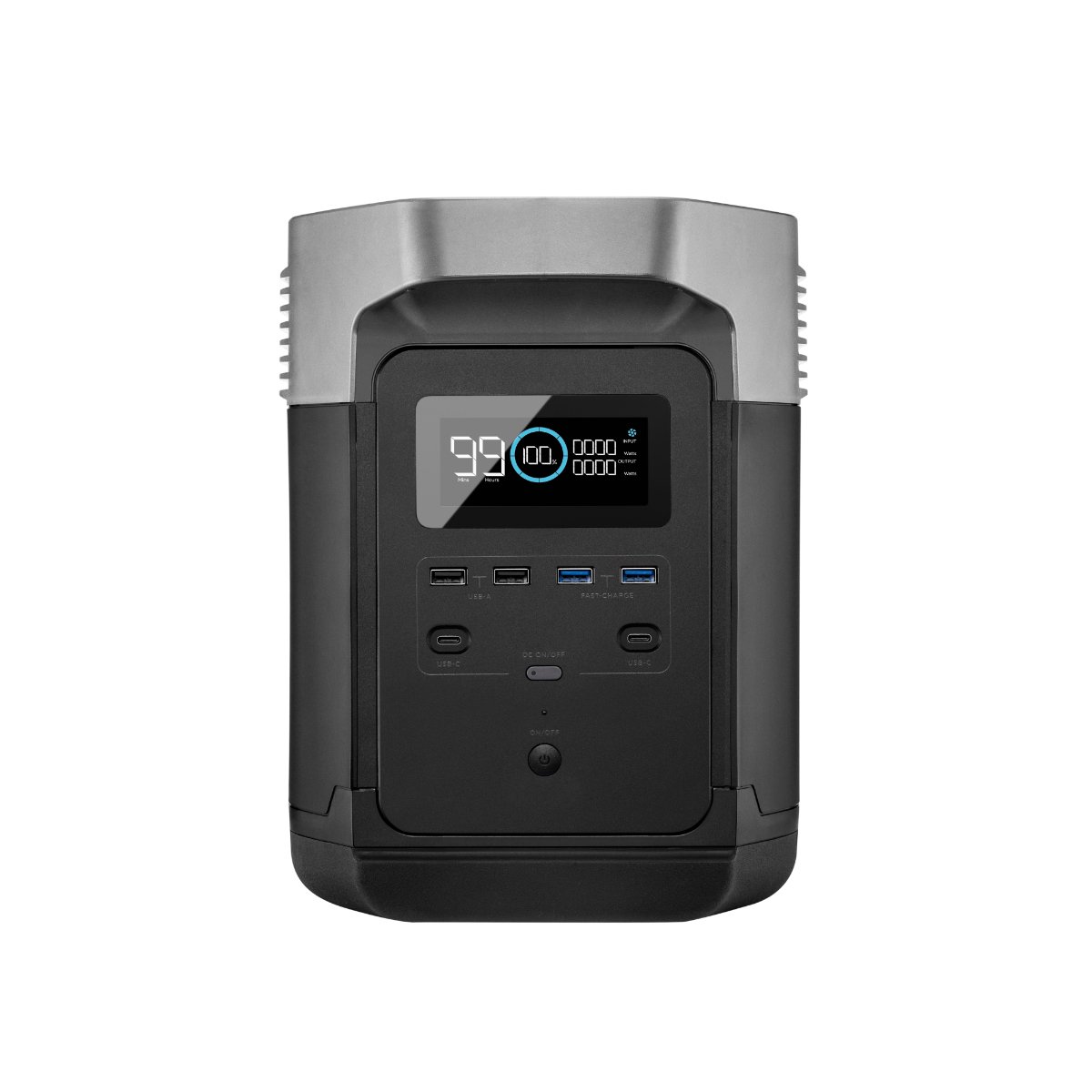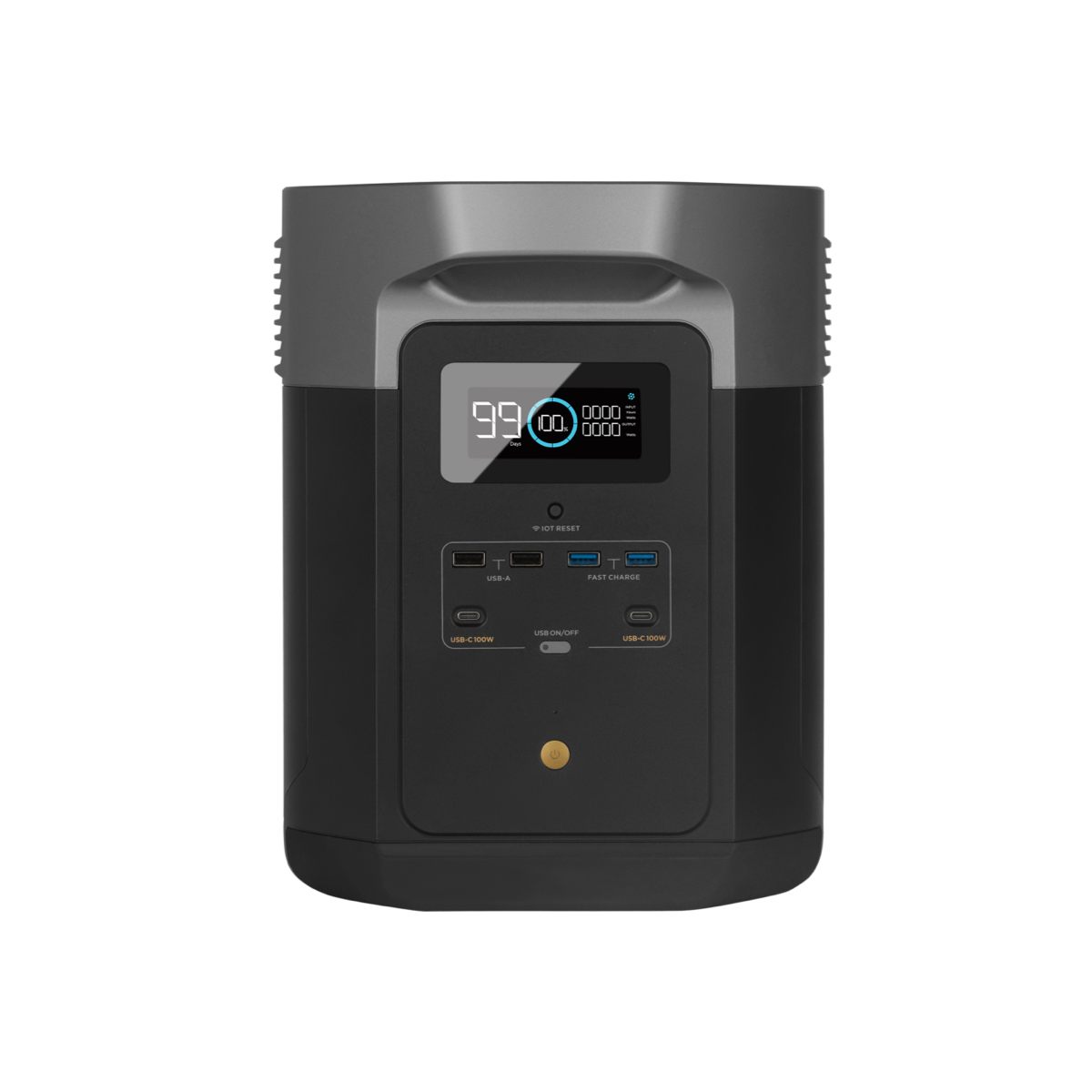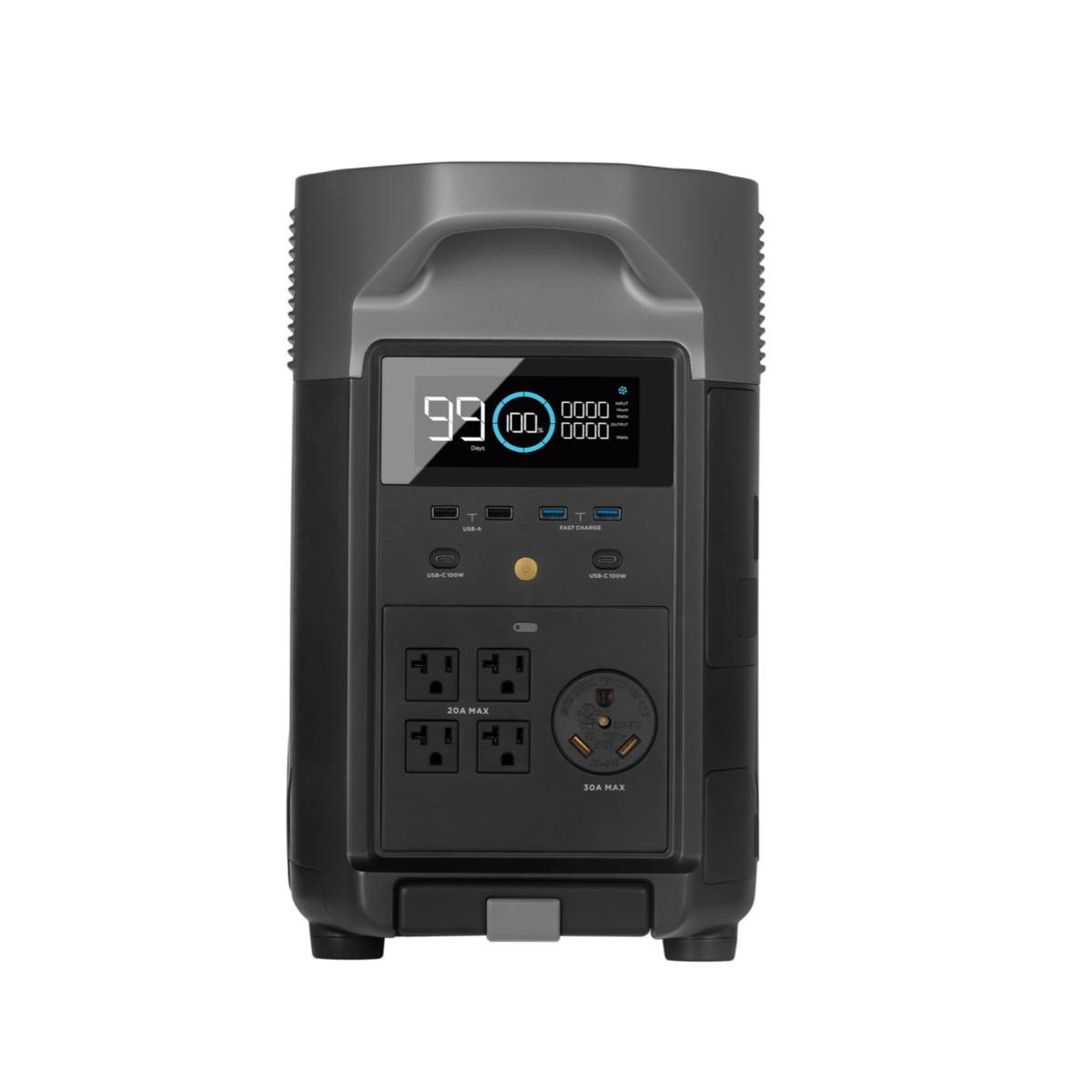If you’re looking for more information about the EcoFlow DELTA portable power station, or you’re experiencing problems with your unit, our support specialists have rounded up the answers to your most popular questions. Keep reading for EcoFlow DELTA specs and troubleshooting fixes.

EcoFlow DELTA
| Capacity | 1260Wh |
| Output | 1800W |
| Solar Input | 400W |
General Overview

EcoFlow DELTA has a battery capacity of 1260Wh (350,000mAh), but we also have the EcoFlow DELTA (1000), with a lower capacity of 1008Wh (280,000mAh) To expand DELTA’s capacity to 2520Wh, you can connect two EcoFlow DELTA units in series.
Using NCM battery chemistry, EcoFlow DELTA has a lifespan of around 800 cycles before it drops to an 80% capacity.
1. Keep it within 20–30°C (68–86°F) and away from water and heat.
2. For safety reasons, do not store EcoFlow DELTA above 45°C (113°F) or below −10°C (−14°F) for extended periods.
3. For long-term storage, discharge the battery to 30% and charge it to 85% every three months (products that have not been charged and discharged for more than 6 months are not covered under the product warranty).
4. If the remaining battery is less than 1% after you finish using the product, please recharge it to 60% before storing it. If the product is left idle for a long time with a severely low battery, this may cause irreversible damage to the battery cell, and the product service life will be shortened.
5. If the product has been idle for too long and the battery is severely low, it will enter a deep sleep protection mode. In such cases, please charge the product before using it again.
It depends on what you’re running. EcoFlow DELTA can power a PC for a little over 2 hours or a Wi-Fi router for up to 36!
Yes! EcoFlow DELTA can run a standard 120W refrigerator for up to 15 hours. With a surge wattage of 3300, EcoFlow DELTA can also deal with a fridge’s startup surge.
No, EcoFlow DELTA doesn’t have Wi-Fi or Bluetooth.
You can check out this tutorial video to see how to use EcoFlow DELTA for the first time:
https://www.youtube.com/watch?v=WVnvqU2W8ZM&t=1s
You can also download the EcoFlow DELTA manual here.
DELTA’s warranty is for 24 months.
The only difference between EcoFlow DELTA 1000 and 1300 is capacity. While EcoFlow DELTA 1000 has a capacity of 1008Wh, EcoFlow DELTA 1300 is 1260Wh.
The main differences between EcoFlow DELTA and DELTA Max are that DELTA Max has greater storage capacity as well as higher AC output wattage. Both EcoFlow DELTA and DELTA Max use nickel cadmium battery chemistry, which means a significantly shorter cycle life and inferior performance to the updated EcoFlow DELTA 2 and DELTA 2 Max.
Aside from sharing a name, comparing EcoFlow DELTA to DELTA Pro Ultra is like comparing apples to oranges. Both models store and output electricity and support charging with solar panels. But while the EcoFlow DELTA can run a few essential appliances off-grid for a few hours, DELTA Pro Ultra can power an entire home off-grid for up to a month. You can plug one 400W portable solar panel into EcoFlow DELTA, but DELTA Pro Ultra supports up to 42 x EcoFlow 400W rigid solar panels at once.

EcoFlow DELTA
| Capacity 1260Wh |
| Expandability Up to 2520Wh |
| Output 1800W |

EcoFlow DELTA 2
| Capacity 1260Wh |
| Expandability Up to 3040Wh |
| Output 2200W |

EcoFlow DELTA Max
| Capacity 2016Wh |
| Expandability Up to 6048Wh |
| Output 3400W |

EcoFlow DELTA Pro
| Capacity 3600Wh |
| Expandability Up to 25kWh |
| Output 3600W |

EcoFlow DELTA Pro Ultra
| Storage: 6kWh |
| Expandability: 90kWh |
| AC Output: 7.2kW |
| Output Expandability: 21.6kW |
EcoFlow DELTA Pro 3 and DELTA Pro Ultra feature proprietary X-Core 3.0 tech architecture, providing industry-leading performance, safety, and intelligence.
X-Core 3.0 delivers the following benefits.
- X-Stream delivers record-speed charging — only 50 minutes
- X-Boost’s revolutionary soft-start algorithm supports up to 6000W of appliances and central HVAC systems with just one unit
- X-Link parallel expansion provides up to 21.6kW of output power and 90kWh of electricity storage
- X-Quiet volume minimization means whisper-quiet operation at an industry-best 30dB*
- X-Fusion outpowers the grid by providing up to 7000W of electricity output from a single AC outlet in bypass mode. Standard household plugs deliver only 1800W. Plug in EcoFlow DELTA Pro 3 or DELTA Pro Ultra and increase your output by close to 300%
- X-Guard is a protective triad of structure, material, and AI that keeps your home and family safe. It can even self-extinguish in the unlikely event of a fire.
Find out more about X-Core 3.0 here.
If you’re uncertain about how to select the best Delta portable power station for your needs, I recommend watching this video for assistance.
Charging

You can charge it from a wall outlet, car outlet, and solar panel. From an AC outlet, you can use 1200W to fully charge in only 1.6 hours. Using a car charging outlet will take approximately 13.5 hours to charge, while 400W solar input can top up EcoFlow DELTA in as fast as 3.5 hours (2×220W Solar Panels / 4×110W Solar Panels, two series, two parallel).
Yes, you can also charge an EcoFlow DELTA with a gas generator that provides AC power that is 100V-120V (50Hz/60Hz) and at least 1500W.
Yes, EcoFlow DELTA can run your devices when connected to an AC input, car outlet, or solar panel. However, bear in mind that powering appliances will slow down the recharging. If you have two DELTAs connected, you can not charge the main unit.
Yes, EcoFlow DELTA has a universal solar charging port, which makes it compatible with most solar panels that are 10–65V and DC 10A (max). We recommend using solar panels that have a combined wattage of around 400.
When the AC input current remains higher than 20A, the X-Stream charging input port will initiate a self-protection function, and the Overload Protection Switch will automatically pop up. After confirming that there is no product failure, you can press the Overload Protection Switch to resume charging.
Output
No. The operating AC output of EcoFlow DELTA is 1800W (3300W surge power). That means it can start and run most high-wattage appliances, but it can’t run multiple high-wattage devices at once. While EcoFlow DELTA can be a lifesaver for running a few essential appliances, for whole home backup power, look to EcoFlow DELTA Pro Ultra. It can power an entire home with up to 21.6kW of AC output and support up to 42 x EcoFlow 400W rigid solar panels.
Basically, EcoFlow DELTA can power anything that’s up to 1800W, and that doesn’t peak above 3300W*. That covers around 90% of essential household devices. EcoFlow DELTA also includes a surge wattage of 3300W, that caters for the startup surge of appliances such as fridges, hairdryers, and air conditioners. Run up to 13 devices at once, as long as they don’t cumulatively exceed 1800W.
Here are some of the appliances you can run using DELTA:
Home Backup

Light
10W
36+ hrs

Washer
500-1000W
2+ hrs

CPAP
40W
18-22 hrs

TV
110W
9-18 hrs

Fridge
150W
7-10 hrs

Hair Dryer
1600W
0.6-3.3 hrs

Microwave
1000W
1-1.8 hrs

Coffee Maker
600W
60 Cups
Off-grid Life

Phone
3Ah
100+ X

Grill
1650W
0.6-1.2 hrs

Laptop
60W
16+ hrs

Frying Pan
1500W
0.7-1.2 hrs

Camera
18Wh
63+ X

Blender
400W
2.5+ hrs

Drone
60Wh
16+ X

Car
1800W
5-7 Km
Yes, as long as the combined output of what you’re charging doesn’t exceed 1800W*. We recommend testing your devices one at a time to see if they’re compatible with DELTA.
1. If you’re trying to power something through DC or AC charging, check that the ON/OFF buttons for AC and DC are on.
2. If a device is drawing less than 1 watt from DELTA, it won’t show up on the LCD screen even though power is going to it.
3. If there is an overload protection indicator on the LCD screen, it means one or more things are trying to pull more than 1800W (or 3300W during a surge)*.
*The 4-outlet version of EcoFlow DELTA has 11 outlets and output of 1600W (3100W surge).
EcoFlow DELTA may be experiencing AC output overload.
1. First, check to see if the connected device meets the unit’s power range.
2. In EPS mode, EcoFlow DELTA supports a maximum of 1400W. Confirm whether the electrical equipment is within this range.
3. The power of the electrical equipment is too large, causing it to fail to operate.
EcoFlow DELTA may be experiencing DC output overload.
1. The output of the DC/car charger is overloaded. Check that the rated current of the device is under 8A. If the current is too high, it will cause overload, and the car charger may overheat.
2. The output of the DC-USB-Type C is overloaded. Confirm whether the electrical equipment is within the current limit of the outlet.
Troubleshooting

You can do an SoC (state of charge) calibration by fully discharging and recharging the battery three times.
If your unit is several years old, you may have reached 800 cycles, whereby the capacity is reduced to 80% and will not recharge to 100%.
1. Make sure your vehicle’s engine is on when trying to charge DELTA.
2. If other devices with a car outlet plug don’t work, it could be a problem with your car outlet.
3. If a solar panel or a third-party XT60 cable can charge DELTA, it could be your XT60 charging cable.
No, but it can be used as an emergency power source (EPS). Here’s the difference.
When your EcoFlow DELTA is plugged into the wall, anything plugged into it gets power from the grid, not its battery. If power from the grid stops, EcoFlow DELTA automatically switches to its battery supply mode within 30 milliseconds. That means anything connected will not have power for 30 milliseconds, which may mean desktop computers and data servers turn off. UPS is not necessary for most devices, but you’ll have to determine this for yourself.
Since EcoFlow DELTA can be used as an EPS, it is possible to leave EcoFlow DELTA plugged in at all times.
When you connect DELTA’s AC Input Port to grid power using an AC charging cable, you can power electrical devices via the AC Output Sockets (AC power will come from the grid and not the power station in this situation). In case of a sudden blackout, the product can automatically switch to battery-powered supply mode within 30ms.
Place EcoFlow DELTA on a hard surface.
1. The battery may have died.
2. EcoFlow DELTA will automatically turn off if the AC and DC power buttons are turned off, and there is no input or output power for 30 minutes.
1. EcoFlow DELTA might not have enough battery. Try charging it and restarting it.
2. If DELTA’s battery dropped to 0%, you might see an overheating protection icon on the LCD screen. Wait for the unit to cool before recharging it.
3. If there is no response after you short press or long press (3 seconds), the Main Power Button, then contact our customer service team.
No, but you can connect up to 2 EcoFlow DELTA units for twice the battery life.
1. Fully charge both DELTAs.
2. Make sure they’re disconnected from the wall when being used.
3. Plug one EcoFlow DELTA into the other’s AC wall outlet.
EcoFlow DELTA Tutorial
You can watch the EcoFlow DELTA tutorial below:
We hope these FAQs answered your question. If you have anything else you’d like to know, give us a shout at EcoFlow Support or leave us a question in the comments below!
*Under 2000W output

great!
Can I use 1 – 390 watt solar panel and 3- 100 watt panels into my ecoflow delta pro?
Yes of course, if you wish to use solar panels from third party, please make sure there is no MPPT board in your solar panel.
Delta pro was fine yesterday, Today it will only accept 690 w from the same AC source
Suggestions?
Hi there,
Please reach out to our after-sale support team at support@ecoflow.com for detailed investigation, please rest assured we offer 4 years warranty for the Delta pro.
Why can’t the extra battery pack be added to the ecoflow plus? It seems like it would fit just like the other base ecoflow and the ecoflow max versions.
Delta dont have a port for extra battery to connect, so it is not expandable, The the newly released Delta 2 has port to connect with extra battery.
How do you charge to only 85%? Use switched outlet, or pull plug?
Hi, you can set it on EcoFlow app
Thus nice product
Should one leave the Ecoflow plugged in all the time or not?
Hi there,
It is recommended to unplug the device after it is fully charged and follow the storage method in the user’s manual.
very clear and good article easy to understand. Thank you
Thank you so much for your support!
What is the best position for the battery to be sitting in during storage time. Can I store then stand up right with handle facing up or do they have to be kept horizontal with the handle facing forward
Batteries should be stored in a well-ventilated, dry area kept between 40 and 80 degrees Fahrenheit. They should be stored away from direct sunlight, heat sources, and water. Batteries should be stacked so that they’re stable and won’t be bumped, knocked over, battery should stand up right with handle facing up